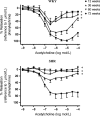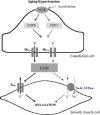Reduced activity of SKC a and Na-K ATPase underlies the accelerated impairment of EDH-type relaxations in mesenteric arteries of aging spontaneously hypertensive rats
- PMID: 26171229
- PMCID: PMC4492766
- DOI: 10.1002/prp2.150
Reduced activity of SKC a and Na-K ATPase underlies the accelerated impairment of EDH-type relaxations in mesenteric arteries of aging spontaneously hypertensive rats
Abstract
Aging is accompanied by endothelial dysfunction due to reduced bioavailability of nitric oxide (NO) and/or reduced endothelium-dependent hyperpolarizations (EDH). This study examines the hypothesis that hypertension aggravates the impairment of EDH-type relaxation due to aging. EDH-type relaxations were studied in superior mesenteric arteries isolated from Wistar Kyoto (WKY) and spontaneously hypertensive (SHR) rats of 12, 36, 60, and 72 weeks of age. EDH-type relaxations in WKY were reduced with aging, and this was associated with an impairment of the function of small-conductance calcium-activated potassium channels (SKC a) and sodium-potassium ATPase (Na-K ATPase). EDH-type relaxation in SHR was smaller than that in WKY arteries, and further reduction occurred with aging. Pharmacological experiments suggested a reduced involvement of SKC a and Na-K ATPase and activation of adenosine monophosphate-activated protein kinase and silent information regulator T1 (sirtuin-1; SIRT1) in mesenteric arteries of 12-week-old SHR. These pharmacological findings suggest that in superior mesenteric arteries of the rat, the reduction in EDH-type relaxation occurs with aging and that such a reduction is exacerbated in hypertension. The latter exacerbation appears to involve proteins associated with the process of cellular senescence and is related to impaired function of SKC a and Na-K ATPase, a phenomenon that is also observed in mesenteric arteries of older normotensive rats.
Keywords: Aging; endothelial dysfunction; endothelium-derived hyperpolarization; hypertension; small-conductance calcium-activated potassium channel; sodium–potassium ATPase.
Figures








Similar articles
-
Modulation of Cardiovascular Function in Primary Hypertension in Rat by SKA-31, an Activator of KCa2.x and KCa3.1 Channels.Int J Mol Sci. 2019 Aug 23;20(17):4118. doi: 10.3390/ijms20174118. Int J Mol Sci. 2019. PMID: 31450834 Free PMC article.
-
Downregulation of Endothelial Transient Receptor Potential Vanilloid Type 4 Channel and Small-Conductance of Ca2+-Activated K+ Channels Underpins Impaired Endothelium-Dependent Hyperpolarization in Hypertension.Hypertension. 2017 Jan;69(1):143-153. doi: 10.1161/HYPERTENSIONAHA.116.07110. Epub 2016 Nov 21. Hypertension. 2017. PMID: 27872234
-
Upregulation of heme oxygenase-1 potentiates EDH-type relaxations in the mesenteric artery of the spontaneously hypertensive rat.Am J Physiol Heart Circ Physiol. 2013 Nov 15;305(10):H1471-83. doi: 10.1152/ajpheart.00962.2012. Epub 2013 Sep 6. Am J Physiol Heart Circ Physiol. 2013. PMID: 24014672
-
K(Ca)3.1 channel downregulation and impaired endothelium-derived hyperpolarization-type relaxation in pulmonary arteries from chronically hypoxic rats.Exp Physiol. 2013 Apr;98(4):957-69. doi: 10.1113/expphysiol.2012.066340. Epub 2012 Dec 13. Exp Physiol. 2013. PMID: 23243147
-
Endothelium-dependent hyperpolarization: age, gender and blood pressure, do they matter?Acta Physiol (Oxf). 2017 Jan;219(1):108-123. doi: 10.1111/apha.12628. Epub 2015 Dec 1. Acta Physiol (Oxf). 2017. PMID: 26548576 Review.
Cited by
-
Modulation of Cardiovascular Function in Primary Hypertension in Rat by SKA-31, an Activator of KCa2.x and KCa3.1 Channels.Int J Mol Sci. 2019 Aug 23;20(17):4118. doi: 10.3390/ijms20174118. Int J Mol Sci. 2019. PMID: 31450834 Free PMC article.
-
Estrogenic vascular effects are diminished by chronological aging.Sci Rep. 2017 Sep 22;7(1):12153. doi: 10.1038/s41598-017-12153-5. Sci Rep. 2017. PMID: 28939871 Free PMC article.
-
The machinery of healthy vasodilatation: an overview.Pflugers Arch. 2025 Jun 6. doi: 10.1007/s00424-025-03096-2. Online ahead of print. Pflugers Arch. 2025. PMID: 40473983 Review.
-
Acute activation of endothelial AMPK surprisingly inhibits endothelium-dependent hyperpolarization-like relaxations in rat mesenteric arteries.Br J Pharmacol. 2019 Aug;176(16):2905-2921. doi: 10.1111/bph.14716. Epub 2019 Jul 4. Br J Pharmacol. 2019. PMID: 31116877 Free PMC article.
-
Endothelium-Dependent Hyperpolarization (EDH) in Hypertension: The Role of Endothelial Ion Channels.Int J Mol Sci. 2018 Jan 21;19(1):315. doi: 10.3390/ijms19010315. Int J Mol Sci. 2018. PMID: 29361737 Free PMC article. Review.
References
-
- Bitterman KJ, Anderson RM, Cohen HY, Latorre-Esteves M, Sinclair DA. Inhibition of silencing and accelerated aging by nicotinamide, a putative negative regulator of yeast sir2 and human SIRT1. J Biol Chem. 2002;227:45009–45107. - PubMed
-
- Brandes RP, Fleming I, Busse R. Endothelial aging. Cardiovasc Res. 2005;66:286–294. - PubMed
-
- Büssemaker E, Popp R, Fisslthaler B, Larson CM, Fleming I, Busse R, et al. Aged spontaneously hypertensive rats exhibit a selective loss of EDHF-mediated relaxation in the renal artery. Hypertension. 2003;42:562–568. - PubMed
-
- Cardillo C, Panza JA. Impaired endothelial regulation of vascular tone in patients with systemic arterial hypertension. Vasc Med. 1998;3:138–144. - PubMed
LinkOut - more resources
Full Text Sources
Other Literature Sources
Miscellaneous

